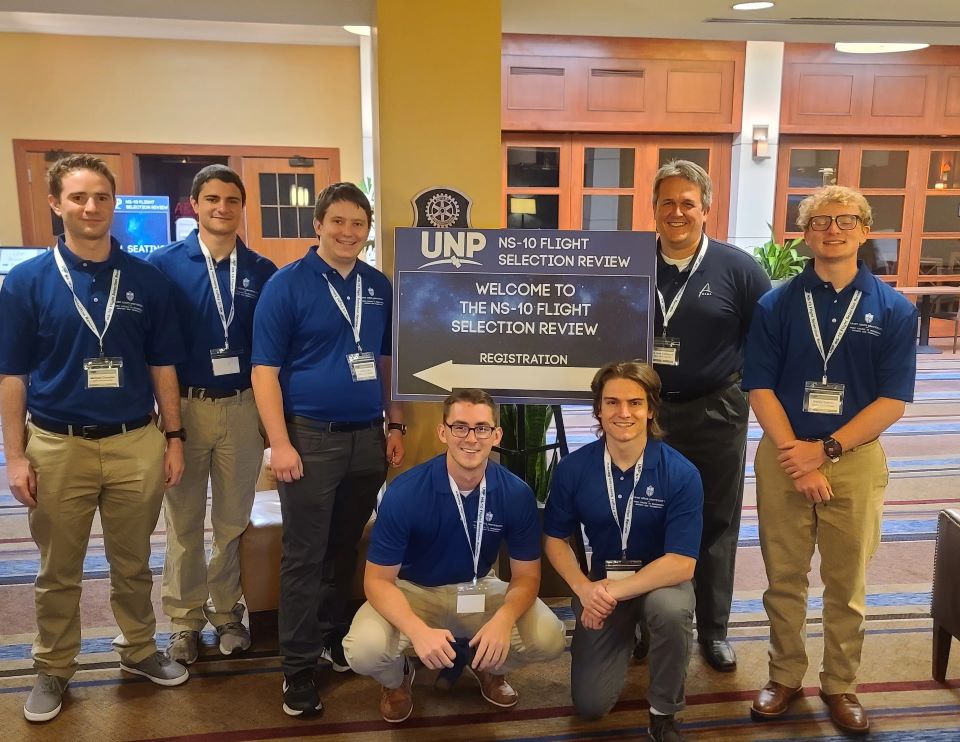SLU Takes ‘DORRE’ Mission to National Nanosatellite Competition
Bridjes O'Neil
Communications Specialist
bridjes.oneil@slu.edu
314-282-5007
Reserved for members of the media.
Students seek proposal to secure a sponsored NASA launch
Saint Louis University, along with nine others from across the country, was invited to participate in the elite University Nanosatellite Program (UNP) in Albuquerque, New Mexico.
DORRE, SLU’s entry into the University Nanosat-10 Competition, didn’t advance into Phase B, but Michael Dompke, a sophomore mechanical engineering student minoring in computer science at SLU’s Parks College of Engineering, Aviation and Technology, remains in high spirits.
“Although SLU was not one of the selected schools, it was a productive experience because we’re already fine-tuning our mission for the next cycle,” said Dompke, who also serves as program manager of SLU’s Space Systems Research Laboratory, the undergraduate research organization whose mission is to perform world-class research in the design, fabrication, and operation of space systems.
Dompke was one of six students who joined Michael Swartwout, Ph.D., associate professor of aerospace and mechanical engineering at Parks College of Engineering, Aviation and Technology, at the competition. A total of eight students worked on the project this summer.
The two-year project culminated the weekend of August 13 when SLU undergraduates presented the DORRE mission to a panel of 12 industry experts. DORRE is a small constellation of spacecraft and ground systems (telescopes). AI techniques are used to automatically detect and sense natural events, such as auroras, thunderstorms, or meteors.
UNP funds U.S. university students and programs to design, build, launch, and operate small satellites with a rigorous concept-to-flight-ready spacecraft development process. UNP is funded by the Air Force Office of Scientific Research (AFOSR) and managed by the Air Force Research Laboratory’s (AFRL) Space Vehicles Directorate (RV).
“St. Louis is far from the centers of space activity; therefore, it’s difficult for our students to get in front of space professionals,” Swartwout said. “It’s real-world experience and networking with people they wouldn’t ordinarily have an opportunity to meet.”
People like retired Boeing engineer Keith Bennett, who Swartwout credits with developing the ideas behind the DORRE mission. Swartwout and Bennett have collaborated on several projects in the past.
"Keith and I joke that his primary job is to come up with the crazy ideas and help us flesh them out,” Swartwout said. “My job is to eliminate the craziest of the crazy ideas and try to re-direct the only slightly crazy ideas into things we can get done.”
The teams were judged on the mission relevance, quality of the design, and ability of the team to finish the project. Participating schools included Missouri University of Science and Technology, Auburn University, Michigan Technological University, Texas A&M, University of Alaska – Fairbanks, University of Buffalo, University of Minnesota, University of Texas – Austin, and Western Michigan University.
Texas A&M, Michigan Tech, and the University of Minnesota advanced in the competition. SLU and Missouri S&T were among universities not selected to continue with Phase B, which would’ve provided additional funds to purchase special instruments and secure a sponsored launch.
“Winning the competition is not the only way to space. We’ve lost the competition before,” said Swartwout, referring to the University Nanosat-6 and University Nanosat-7 competitions. “There are other pathways to take the work that the students have done and see it to completion.”
COPPER was the first spacecraft developed by SLU students and entered the University Nanosat-6 Competition, which ran from 2009-2011. In February 2011, COPPER was selected by NASA for a sponsored launch under its Educational Launch of Nanosatellites (ELaNa) Program. It launched in 2013. Argus was SLU’s entry into the University Nanosat-7 Competition, which ran from 2011-2013.
Swartwout said the team will finish the DORRE mission using other resources and submit a proposal to secure a sponsored launch through NASA.
About Parks College
Saint Louis University's Parks College of Engineering, Aviation and Technology offers aviation degrees and engineering degree programs that enable students to study these technical disciplines in a traditional university setting. As the first federally-recognized flight school, Parks College has a rich history of creating well-rounded leaders in aviation and engineering fields such as civil, electrical, computer, mechanical, biomedical and aerospace.
About Saint Louis University
Founded in 1818, Saint Louis University is one of the nation’s oldest and most prestigious Catholic institutions. Rooted in Jesuit values and its pioneering history as the first university west of the Mississippi River, SLU offers more than 12,000 students a rigorous, transformative education of the whole person. At the core of the University’s diverse community of scholars is SLU’s service-focused mission, which challenges and prepares students to make the world a better, more just place.


















